7 Techniques for Employee Stress Management in the workplace
Stress management is the key to leading a prosperous and productive life. But to manage stress effectively, it is crucial to get to the root of the problem.
The same applies in the workplace as well. As a manager, you need to assess the situation by asking questions like-
- Are your employees missing out on deadlines?
- Have you witnessed a significant drop in productivity?
- Are they least motivated to work?
- Have you seen a rise in their workplace stress levels?
If you answered "yes" to most of the questions above, your staff is most likely stressed out.
Leadership helps to grasp the effects of stress on the employees’ daily lives. Prolonged stress harms the mental and physical health of employees. Moreover, if not addressed in time it can lead to chronic stress that can be detrimental in the long run.
And to help you out with that, this article will focus on varying techniques to manage stress. But let’s get to the basics first.
What is Stress Management?
Stress management is the broad spectrum of techniques that help a person to control their stress levels. The purpose of stress management is to improve the everyday functioning of an employee and increase job satisfaction.
It is common to feel stressed. However, if this stress persists on a daily basis, it can impair our ability to perform. Chronic stress can ultimately lead to serious health complications.
However, one can tackle the issue if one understands the signs of stress and work on resolving it.
With some handy stress management tricks, an employee can:
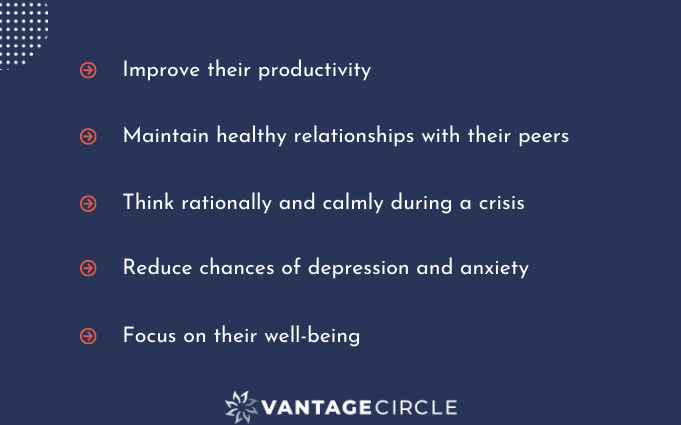
Managers must understand the severity of what stress can lead to and how it impacts the organization. You need to acknowledge it and recognize stress among employees to further stop it from escalating.
Moreover, employees must get exposure and the knowledge to proper stress management. This will make it easy for them to tackle it properly.
Reasons behind High levels of Stress
Everything has a beginning.
The same rule applies to stress as well. It won’t start on its own, right? It has an initial point from where it stems from.
The reasons behind high levels of stress in the workplace can vary. But managers need to selectively emphasize on few of the factors that are troublesome. Below is a list of some common reasons-

For HR leaders to deploy a good stress management system, here are some handy pointers:
-
Survey to find out the reasons for employees' stress
-
Create an action plan of solving the problem
-
Communicate the plan to the employee. Take their inputs into consideration. It will help them feel like they have power over their stressors.
-
Train executives and senior leaders on how to handle burnout and stress among their people
And to initiate such a system, we will give you a headstart on the techniques you need to adopt.
Let’s get started.
7 Techniques to Employee Stress Management
1. A Culture of Rewards and Recognition

Remember, toxic work culture is always the culprit behind high levels of stress in a workplace.
In fact,
57% of people report leaving work feeling exhausted, and that a toxic atmosphere often compounds that stress.
A toxic work environment breeds-
- Unrest
- Low morale
- Workplace bullying
- Harms peer relationships and much more.
A telltale sign of toxic work culture is unhealthy competition and a lack of appreciation for each other.
It is critical for team members to appreciate one other's efforts in order for them to bond and work better together.
The use of rewards and recognition is an excellent technique to cultivate a healthy work atmosphere. It helps the organization in-

It's not enough that recognition is top-dow. It's vital that appreciation should be 360 in nature. This will allow you to elevate employee experience and elevate the recognition process.
But the question remains. How to sustain it for the long term?
We are here to answer your questions. With Vantage Circle’s simple AI-based Rewards and Recognition platform, you can automate the process of recognizing your employees. The platform allows you to-
- Manage a social feed where employees can appreciate each other
- Reward points based on their achievements
- Maintain a constant communication channel with the workforce
- Wish each other on special occasions
And to top it off, employees can access it from multiples devices. So, no matter where your global employees are based, they can recognize on the go.
Learn More about it: Recognize Your Employees and Celebrate Great Work!
2. Make room for regular surveys

Understanding the needs and requirements of the workforce is a crucial aspect of stress management.
As a manager, you need to get a clear picture of-

And to do that, you need to conduct timely surveys that will generate honest feedback from the employees. It will give a clear insight into what the employees think and feel about the organization.
It does not stop after you get feedback from the employees. You need to work on their concerns and solve them as soon as possible. This will reduce the frustration levels and keep stress at the bare minimum.
To further facilitate a feedback system, you will require a tool that will generate timely questions. The Vantage Pulse Survey tool aims to do just that and generate real-time feedback. It provides the Admin with the ability to manage, oversee, and analyze the survey to find the company's strengths and weaknesses.
Furthermore, the tool also allows easy customization and targets critical issues. In return, it helps to measure the employee engagement levels and improve them in the long term.
Explore more: Get Real-Time Insights with Our Survey Tool
3. Good employee perks and benefits

Employee job satisfaction is crucial in the present scenario. If your employees are not satisfied with their job, it will negatively impact customer satisfaction. As a result, it affects customer retention resulting in a decreased annual revenue.
You do not want that at any cost.
As a manager, you need to keep your employees satisfied with the help of various employee perks and benefits. It can include-

One significant advantage of having an employee benefits program is that it helps employees save money because of the exclusive offers. Plus, employees get the freedom to choose their choice of deals available to them.
And to kickstart such a program, you can check Vantage Perks. It provides specially curated deals and discounts for corporate employees. The platform also has a wide range of global gift card catalogs that employees can choose from. Another added benefit is that employees can convert their Vantage points to gift cards at any time.
Want to Know more about Employee Perks? Click here!
4. Focusing on Employee health and well-being

Employees' stress levels have skyrocketed as a result of the pandemic. With no opportunity to socialize and destress from work, it has made life difficult.
And to make matters worse, a survey found that 58% of employees experienced symptoms of depression in the last year.
But this also opened the window for organizations to focus on employee health and well-being. With work-from-home policies still active worldwide, the need to promote and prioritize employee health is crucial.
As a leader, you can-
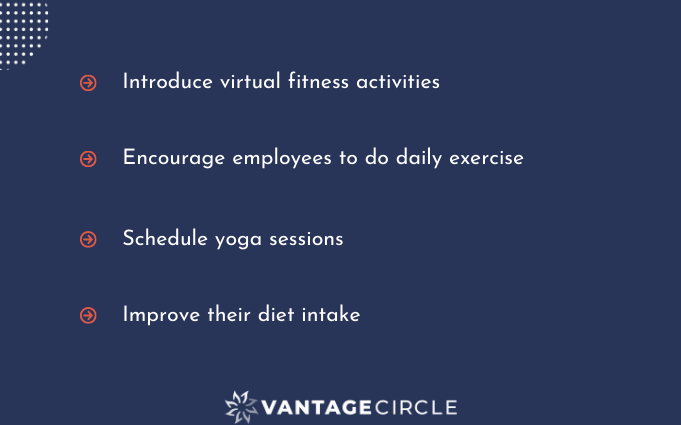
It will help them invest their free time in releasing stress. That is why it is critical that employees receive support in improving and tracking their overall well-being.
To further assist the employees, Vantage Fit provides an automated platform to lead a healthy lifestyle. The platform allows the employees to-
- Keep a record of their food and water intake
- Try out different physical activities
- Join weekly competitions organized by the company
- Track their mood based on their daily emotions
- Measure heart rate
Managers need to make sure that employees reduce stress on time to improve their engagement. And with Vantage Fit, you can elevate your efforts and create a healthy and mindful culture.
Want to keep Your Workforce Healthy and Productive? To know more, Click here!
5. Encouraging Self-Management

Another crucial technique that helps in stress management is self-management.
Self-management is the ability to manage one’s behaviors, thoughts, and emotions in different situations. The primary goal of self-management is to improve performance and work efficiency.
But how is self-management related to stress management?
Well, to start with, self-management helps you understand your own strengths and weaknesses. When an individual acknowledges their flaws, it gives them the opportunity to improve themselves.
It encourages an employee to-
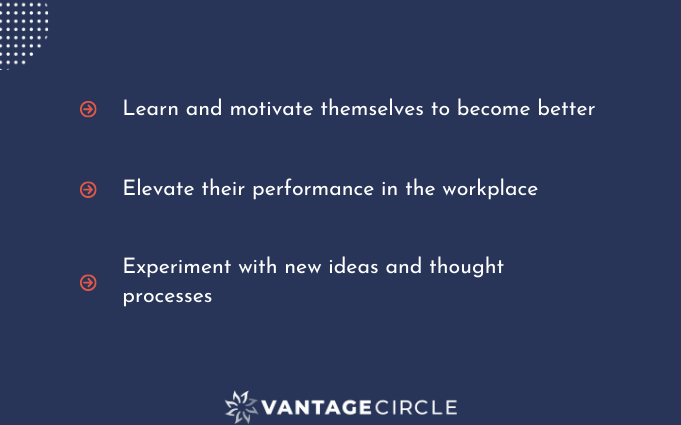
In the long run, it helps the employees in upskilling and enhances their ability to work. It broadens their knowledge in their area of expertise. Thus, employees will feel more competent, and the stress related to personal growth will be eased.
Read more: 6 Self-Management Skills for the Workforce
6. Resolving Conflicts between employees

One of the driving factors that lead to stress in the workplace is a conflict between team members.
Conflicts are inevitable in an organization. They are bound to happen. But you can reduce employee stress in the workplace with good conflict resolution skills.
As a manager, you need to have the right conflict resolution skills and follow the necessary steps. You have to make sure that the situation remains under control. As a moderator you need to-
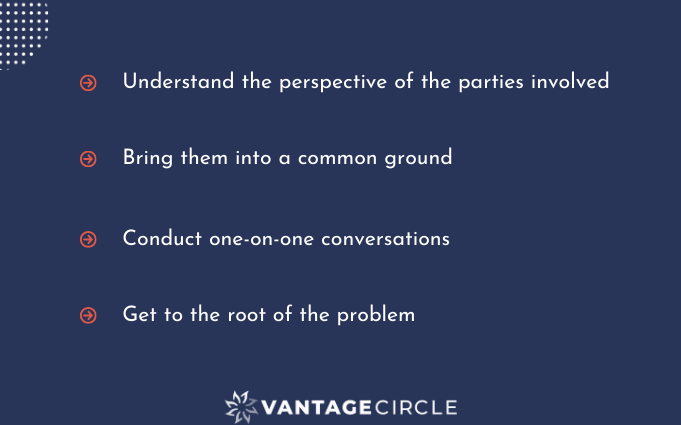
The main focus should be on maintaining team harmony and reducing tension between team members. You can ask them to take some time off and let them contemplate the situation.
Remember, the sooner you resolve any dispute the better it is for the team and the workplace.
Read more: A Guide to Conflict Resolution in the Workplace
7. Realistic Goal Setting

Imagine being in a situation where you have to accomplish a goal that is unattainable. This can create chaos, frustration and increase stress levels.
It is the same with your employees. If they cannot achieve their goals, it creates a cloud of doubt on their ability. This can further lead to high levels of burnout and stress.
But such situations can be averted. As a leader, you need to set realistic and tangible goals for your employees. Good goal setting includes:
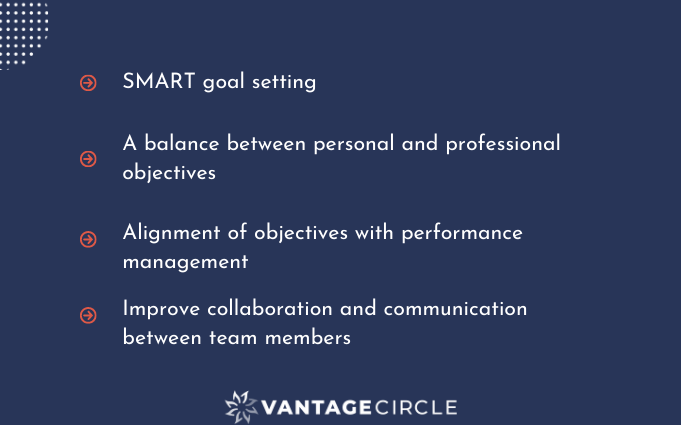
It is important to understand the positive impact of setting up realistic goals. Your main aim should focus on improving the productivity, engagement, and morale of an employee. And it is achievable when employees feel that the organization is not being over-ambitious with its vision.
As a leader, take one step at a time while being rational with your employees.
Learn More: 6 Vital Guidelines for Managers to Set Team Goals
Summing it Up!
Leaders must facilitate stress management sessions. It is beneficial to the employees and paves way for them to manage stress. All you need to do is plan it properly and work around the organizational culture. If you have any more suggestions, do let us know in the comments section below.




















